
all black & white photos this page by Anna Daedalus, 1999
Harriet Sanderson: Lag — A Holding Pattern in Building Nine
by Seattle writer, poet, and critic Robert Mittenthal
. . . the whole problem . . . in modern poetry . . . [is that poets] . . . can't resist, if they have all of these benches and chairs in the room, not to arrange them themselves instead of letting them be arranged by whatever is the source of the poem.
— Jack Spicer, from The Collected Lectures
For Spicer, the source of the poem comes from outside — the poet taking dictation, as it were, from Martians. So, while an artist may have a certain intent, what comes out may be quite different. Rather than fighting to control the outcome (which is what is taught at most creative writing programs and art schools), Spicer is suggesting that artists need to embrace the source, to become better, or more receptive, hosts.
. . . poems [don't follow] the dictation of language. . . . Language is part of the furniture in the room. Language isn't anything of itself. It's something which is in the mind of the host that the parasite (the poem) is invading. Five languages just makes the room structure more difficult, and also, possibly, more usable . . .
— Spicer, ibid.
While this metaphor of embodiment, of this outside source coming in to one's mind/body, may seem like a mystification (how can the artist not arrange — wouldn't that be irresponsible?), perhaps another way of thinking of this is as a breaking of habit. Habits are taught and lived, and can interfere with clear reception, as can a messy room. For Spicer, the structure of the body, of its rooms, cannot be ignored.
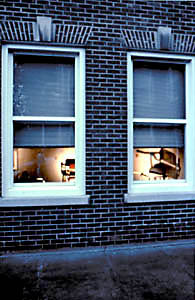
Harriet Sanderson's work taps into a source which is very much a part of her everyday life, and part of the lives of many others the constraints of physical and/or mental disabilities and how these have traditionally been hidden in our culture. Sanderson has spent a lifetime struggling with these issues and realities, having virtually no use of her right hand since she contracted polio at a young age.
In The Parasite, Michel Serres asks the question: "What is work?" And answers, "undoubtedly it is a struggle against noise." (86) Health is a silence of the organs. "Sickness is a noise." The parasite or the source is between silence and noise. "It must be said to be a being or a relation." (230) In this scenario, the host without the parasite is not going to be much of an artist. But beware these powerful terms which can be easily misconstrued, and consider that there is no moral hierarchy between parasite and host. The parasite without a host is no longer a parasite; and vice versa. They need each other or they lose identity. Serres would have us work toward and not run from the noise. ". . . if I approach . . . the noise slowly becomes conversation . . . noise and message exchange roles." (66) So if we approach the parasite's banquet slowly enough, the noise becomes a conversation in which we can participate.
Harriet Sanderson's Lag — A Holding Pattern in Building Nine at the former Sand Point Naval Station is part of Five Sites, a program sponsored by the Seattle Arts Commission, funded by 1% For The Arts. Lag is "an installation of canes and chairs balanced upon one another without fasteners, in ten contiguous areas of building nine." In context at Sand Point, one can easily get wrapped up negotiating the vast array of outdoor sculpture at 1999 Horse Head International which coincided with Five Sites. Amidst the sculptural Easter egg hunt which is Horse Head, Sanderson's installation stands out by recontextualizing an abandoned office building as a kind of outdoor sculpture with illuminated interiors. Inside, she fashions a metaphorical clinic for the ailing aviators and other naval personnel and family members who lived there over the years.
Our eyes are drawn to the architectural skeleton of this otherwise abandoned building by the light emanating from within. As we peer through the buildings' windows, it's as if we were looking back in time. There is an eerie play of absent bodies evoked by arrangements of canes and chairs, mattresses and pillows. A conversation is provoked.
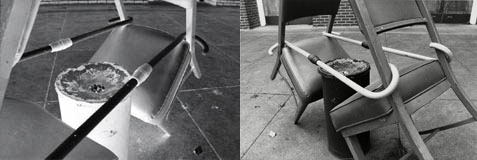
Unlike most installations, we do not enter an enclosed space to interact and measure the physical presence of the artwork against our own bodies. Instead, we find ourselves in a kind of voyeuristic relation that is common in our culture. Looking into the host, what we do not see is as important as what we do see; like a film set, the lights inside project the dance of the canes and chairs into the big screen at the back of our retinas/eyes.
With dramatic shadows cast by cane and chair, this is not exactly a furniture convalescent home nor a walking cane graveyard. There seems to be a hidden chorus of voices sitting on loop leg chairs — the chairs up on cane handles as if they were stilts; several chairs have wandered off for a stroll just outside the building.
Placed on the window in the main entry door is a sign framed in red tape that announces: Hospital Zone. A hospital (etymologically a close relative of "host") is where one goes to attain balance, to quell the noise that has invaded the body; it is the sterile environment that exists specifically for the purpose of controlling the parasite, the site where message and noise can exchange roles.
Trying to live with the noise, to keep it somewhat under control is a balancing act. Contemporary in their impermanence, Sanderson's sculptures are vulnerable; regularly shifting form, they are held together only by basic physics. The chairs and canes are merely leaning on each other, their arrangements shifting in pursuit of a more comfortable (or less noisy) position. Exploring and embracing constraints, a chair is comforted (or perhaps tortured/discomfited) by cut-up mutating canes whose articulating arms contort themselves in a sequence of embraces.
The idea (and fact) of "ten contiguous rooms" suggests interconnection, as if the host body were divided into different functions. There are sleeping rooms, sitting or waiting rooms, and play or living rooms, as well as stairwells and other transitional spaces.
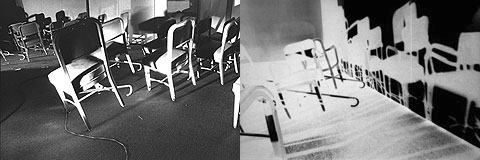
In the big living room, an almost circus atmosphere pervades, a sequence of chairs exercising, leaning in synch to one side or another. Chairs walk inside using their canes as stilts; five chairs hold up a connecting bridge of stacked canes, as if they were playing a game of cards. There is a sequence of (possibly musical) chairs forming a train or daisy chain, four canes holding onto the back of the chair in front, working together to form links between adjacent chairs. Four more chairs form a family, holding canes to make a table, their legs entwined by a tangle of canes locked together under the table.

In what might be considered a store room, a blanket of sleeping canes form figure-eights, a series of moebiuses that suggests a suturing of head to foot to head. The canes fill the floor of a small room, locked in their own quiet embrace — "nevaslip" rubber stops on both ends. The moebius is a form Sanderson has explored in earlier work. In her Acrobat series of prints, bodies eat their tails, a collage of limbs — arms and legs entwined — embrace an empty center. Each print is presented impaled on the canopy frame of a sick bed, as a sort of retablo or get-well wish.
In an adjacent room, mattresses triangulate a boxy space. Chairs face each other standing on pillows which lay on mattresses; canes protrude antenna-like from the chairs, dangling their handles down to form small circles or connection nodes/points. The bedding on the mattress says leave me be. It says let me sleep. It says come back. Stay longer.
We follow a continuous bed of pillows, leaning or laying flat, filling the entire floor and ascending a staircase — leading to a dramatically lighted chair on the landing, canes protruding. So, while canes and chairs explore the physical possibilities of interaction, beds and pillows cushion the pain, completing the furnishings of these rooms. Like a dream of an ascension, chairs climb atop their canes — and vice versa — canes clothing the chairs, forming bridges and interconnections between themselves, building relations.
Lag's internal space can seem orderly and chaotic at the same time. We notice tureens of spitballs and cigarette butts — repositories of past or passing time.
We as their victims, as their mouthpiece must learn to become victims, to become complete pieces of their mouth.
— Spicer (Caterpillar 12, p. 166)
It is difficult to tell whether the objects strewn across the floor are pieces of Sanderson's mouth.
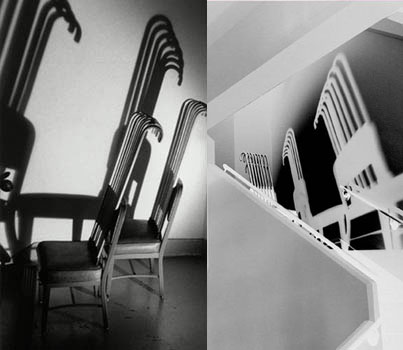
There is a distinct order to the choreographed rooms, but the backdrop or stage setting with its industrial décor is noisy. Sanderson did not repaint or re-carpet the interiors; for the most part, she accepted the stage set for this installation as is, even using chairs available at the site. The messy carpets are a sign of the noise, the chaos that is always hidden behind the threshold of the host.
There is something unsettling in the otherwise harmonious form of chairs and canes. Maybe it is the fact that the chairs are old, and unable to hide scars of their long life. The chairs have a certain nostalgia, something approaching individual personas unlike the canes show no signs of age and are mostly uncut. This tension between the new or generic canes and these battered chairs provides a balance which seems appropriate for a hospital — the sanitary and impersonal versus the worn and diseased.
There are many hidden stories here that will never be told. We come to this installation and discover our own stories, easily imagining patients playing bridge, or toe tapping to phonograph records. As Sanderson explores and perhaps celebrates the dysfunction of the chairs, they work with their canes to stand and walk and finally dance; they begin to attain a life of their own. A sense of joy and pain is evoked.
I usually associate the idea of dancing sitting down with writing — very good writing. The artist's work is to struggle with these chairs and canes to choreograph a dance. With Lag — A Holding Pattern, Sanderson invades a given architectural frame, presenting a window into a metaphorical, hidden body. Rather than following the dictation of what the chairs and canes want to do, Sanderson lets the source of her work arrange the furniture. Having in effect invaded her, this source creates noise which can benefit us, should we choose to approach and converse with it.
— Robert Mittenthal, 1999
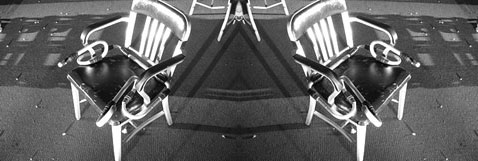
Jack Spicer. p. 9-10 of The House That Jack Built: The Collected Lectures of Jack Spicer. Edited by Peter Gizzi. Hanover, NH: University Press of New England, 1998.
Jack Spicer, Caterpillar 12, Blaser/Spicer issue, p. 166.
Michel Serres. The Parasite. Translated by Lawrence R. Schehr. Baltimore: The Johns Hopkins University Press, 1982.


